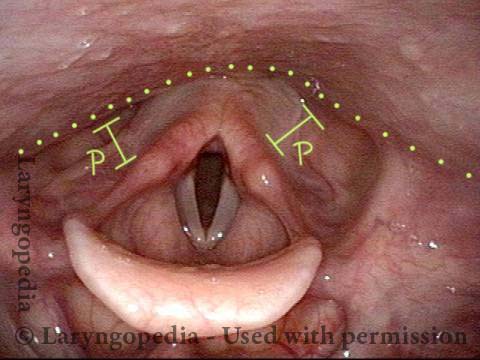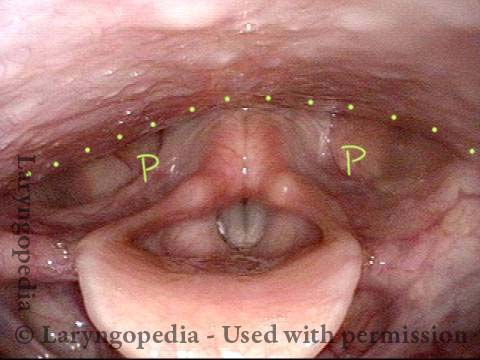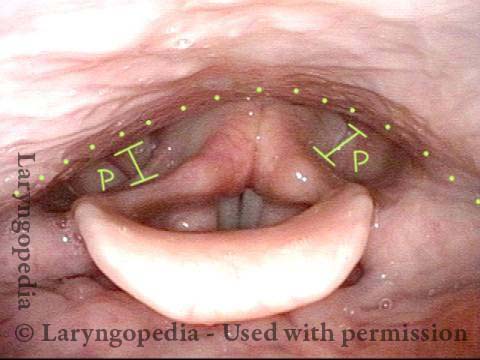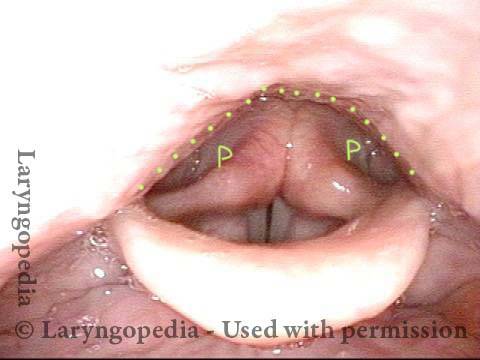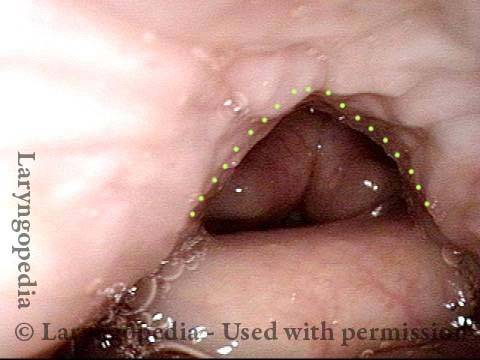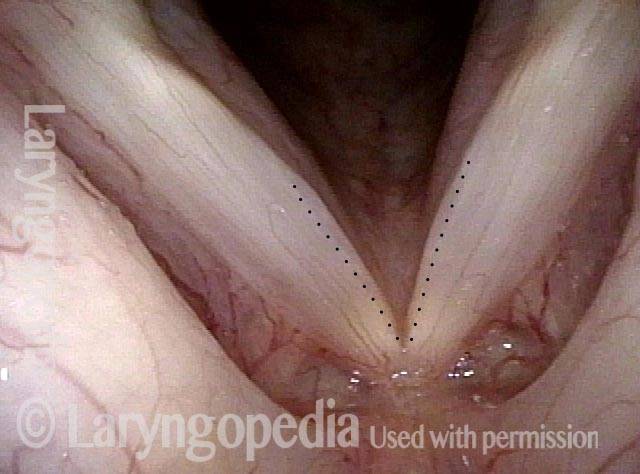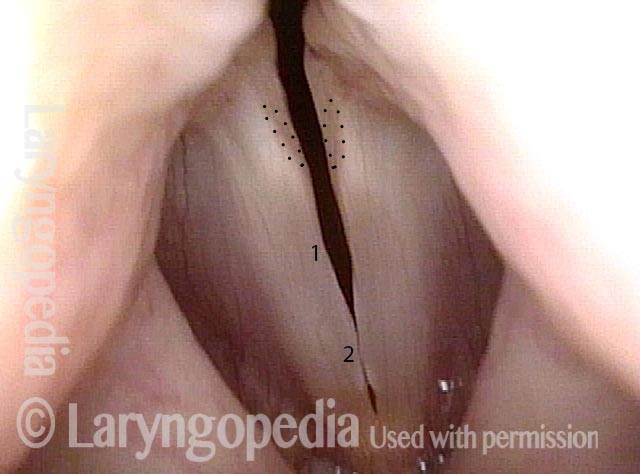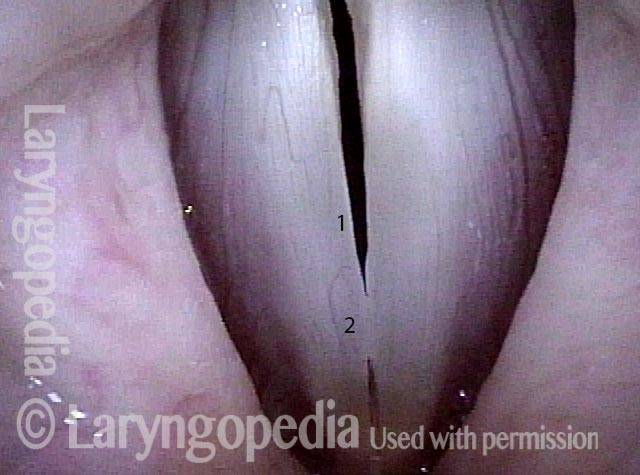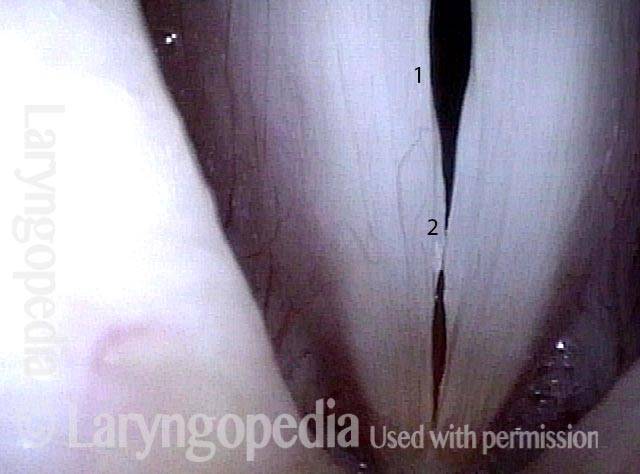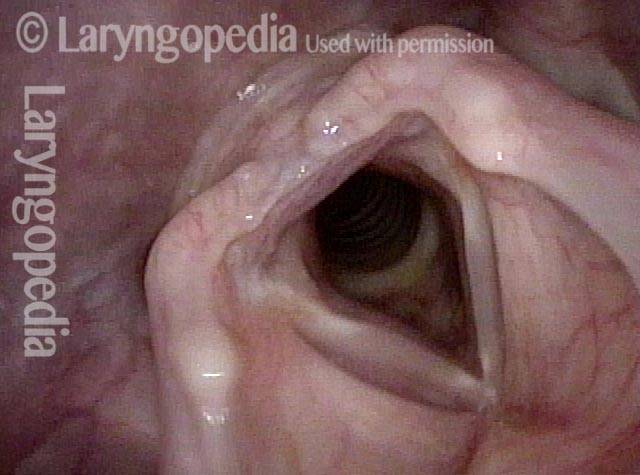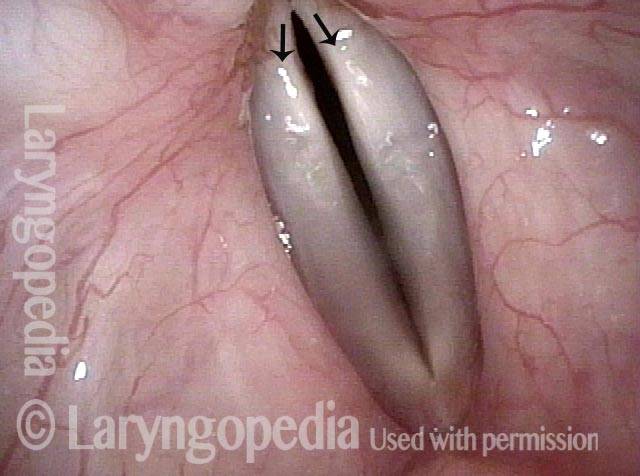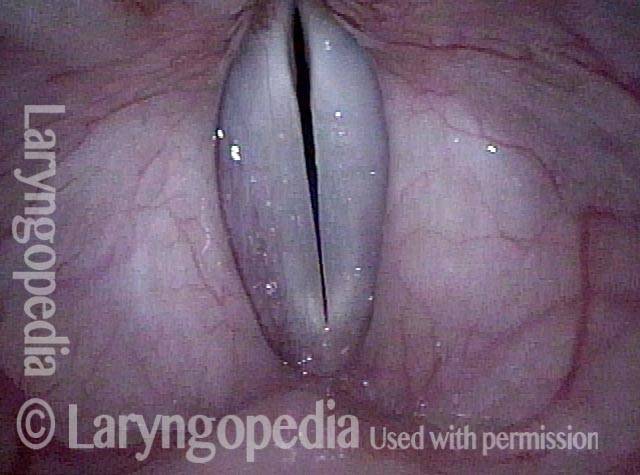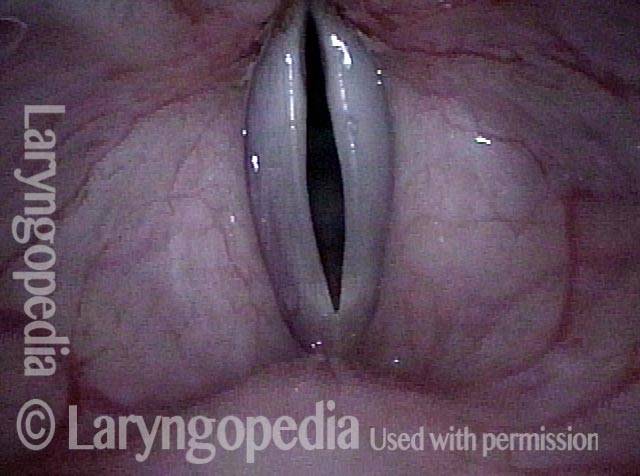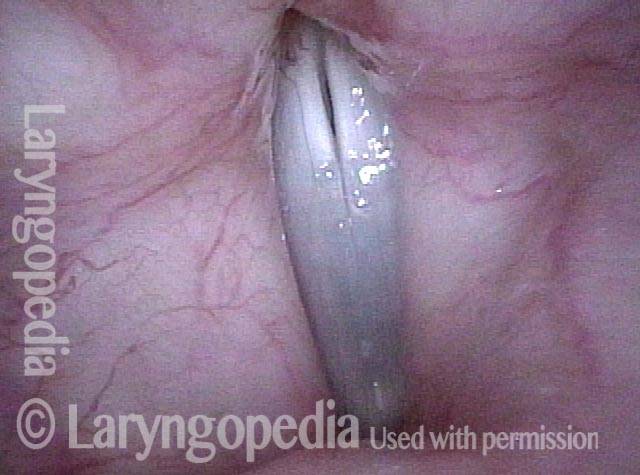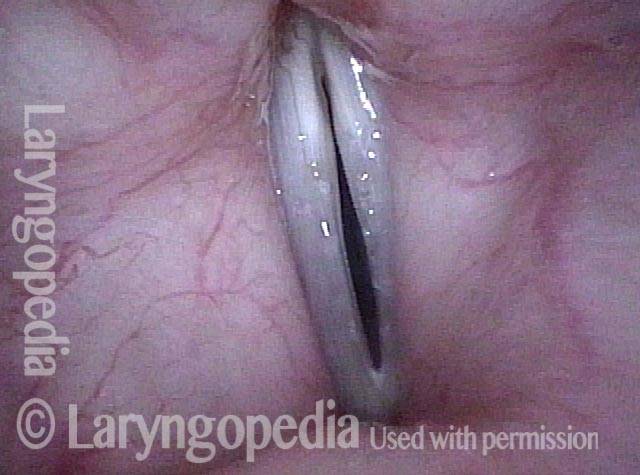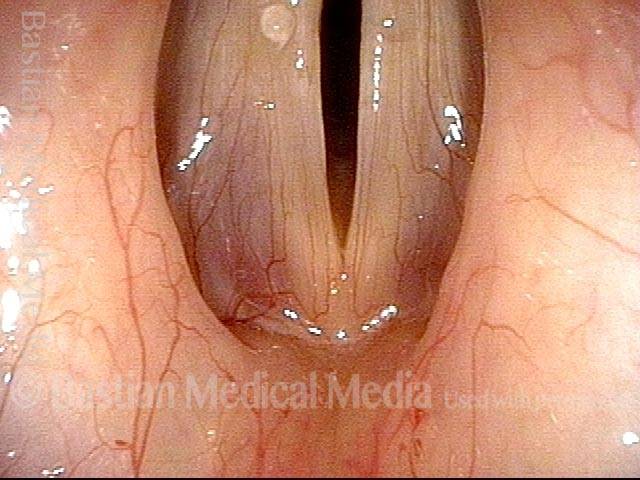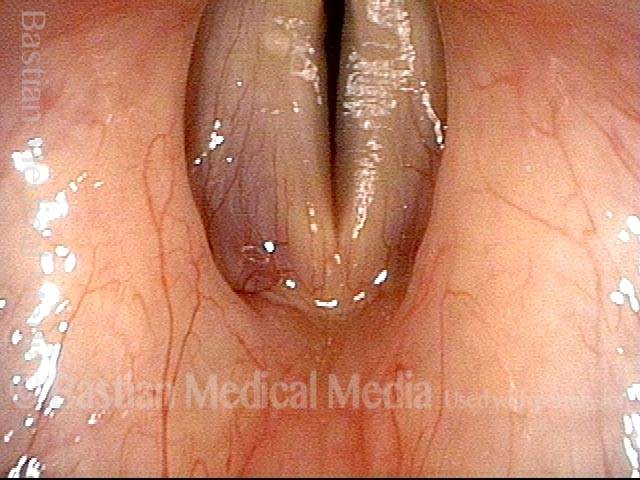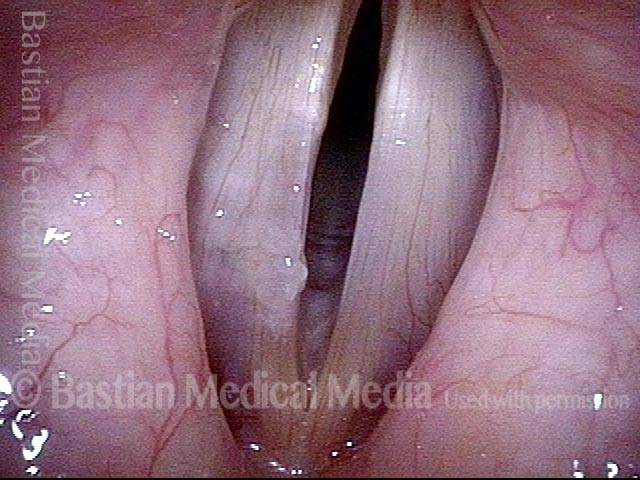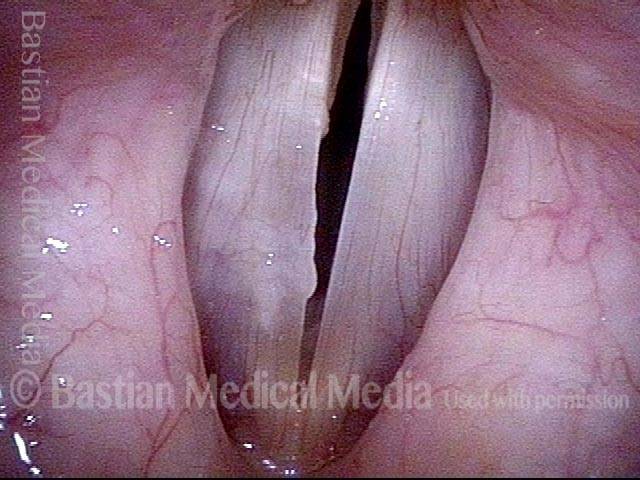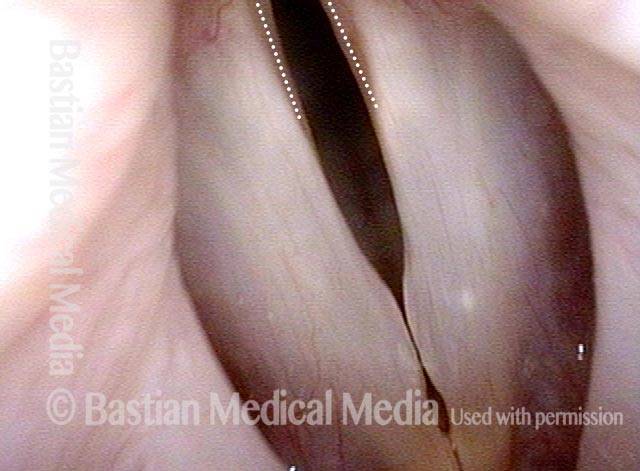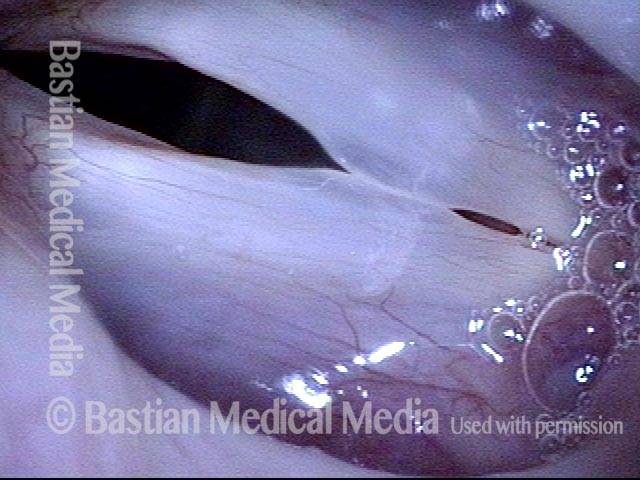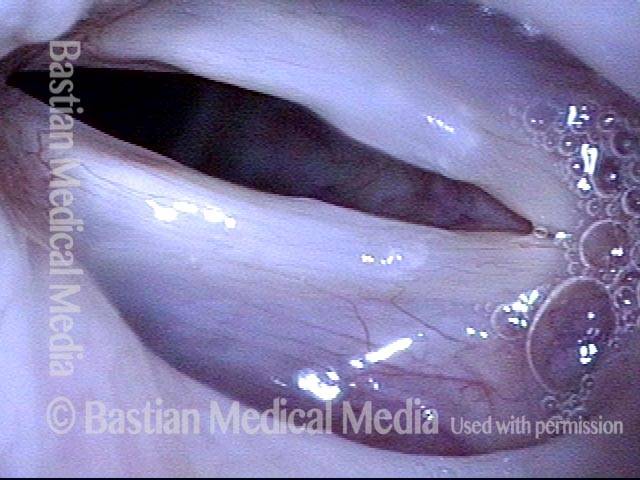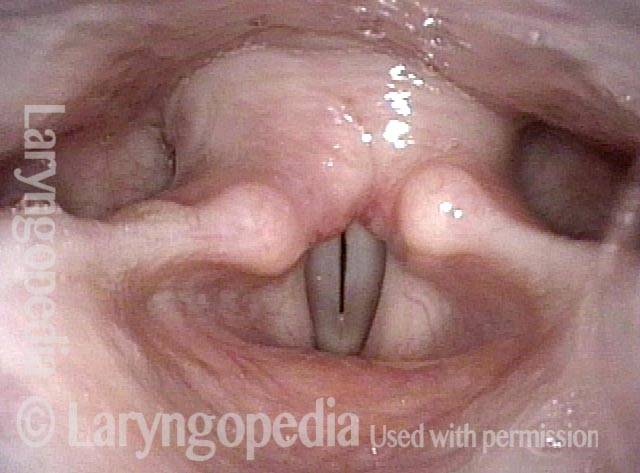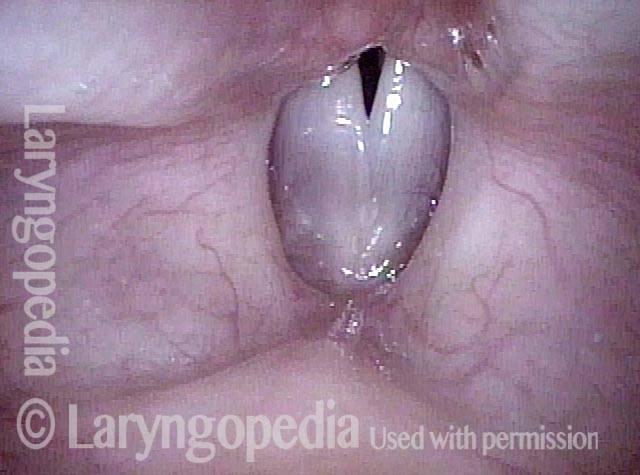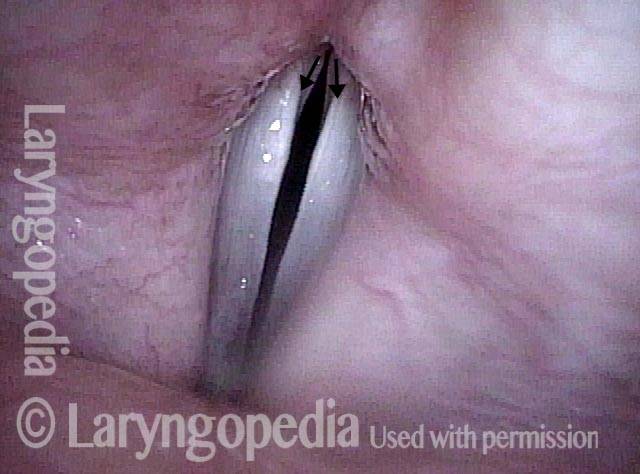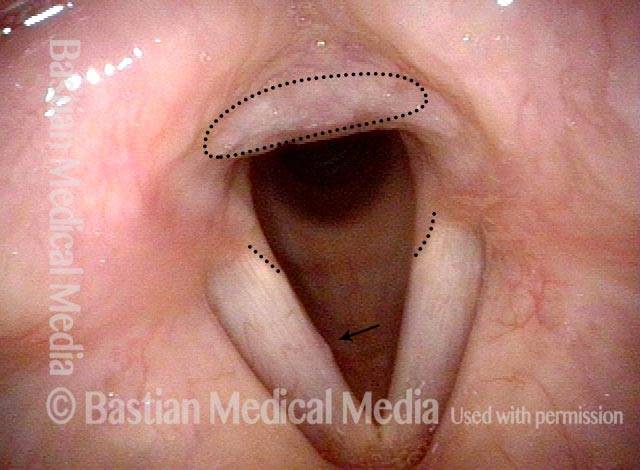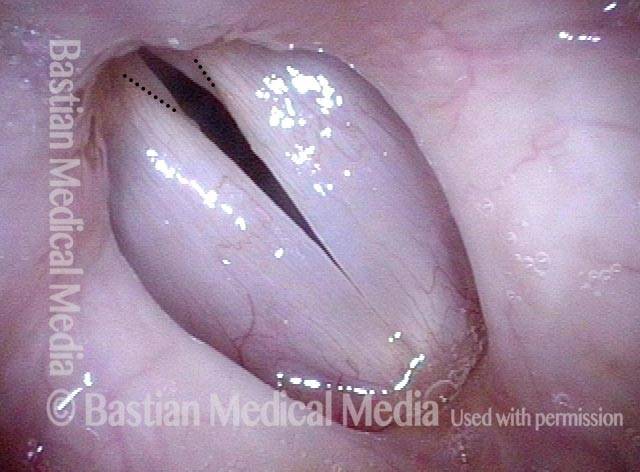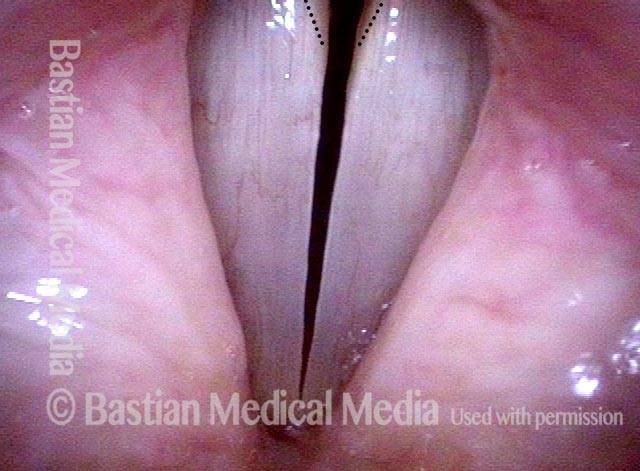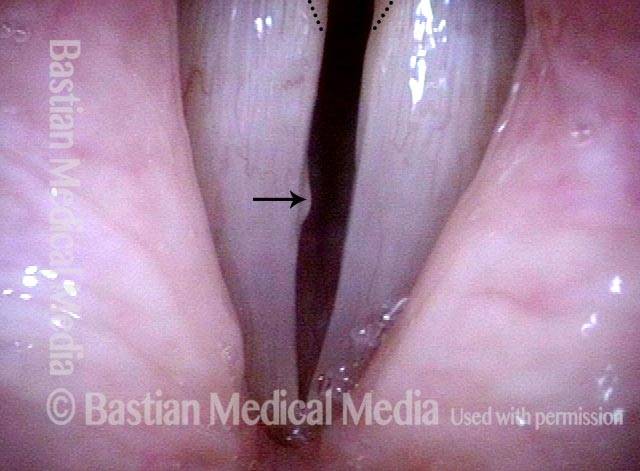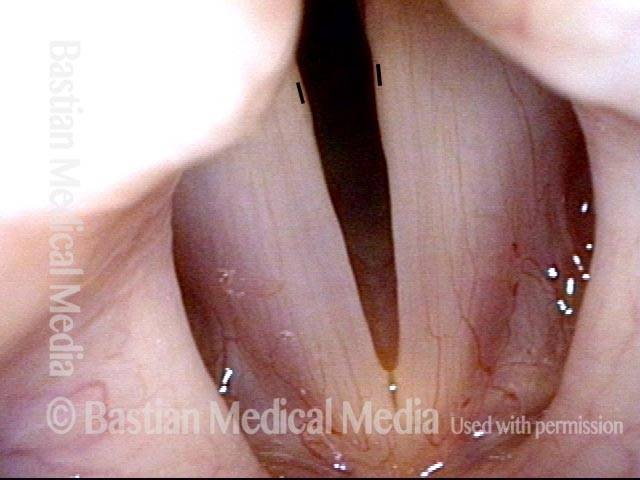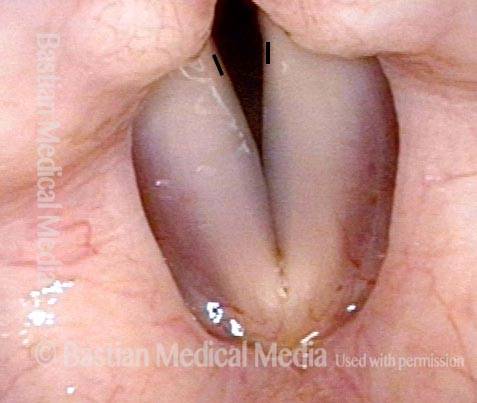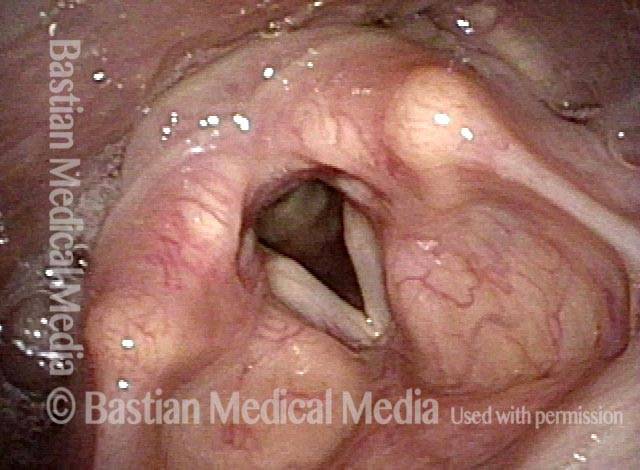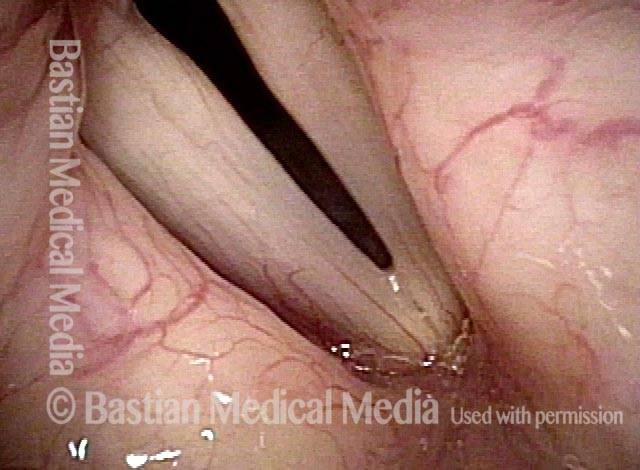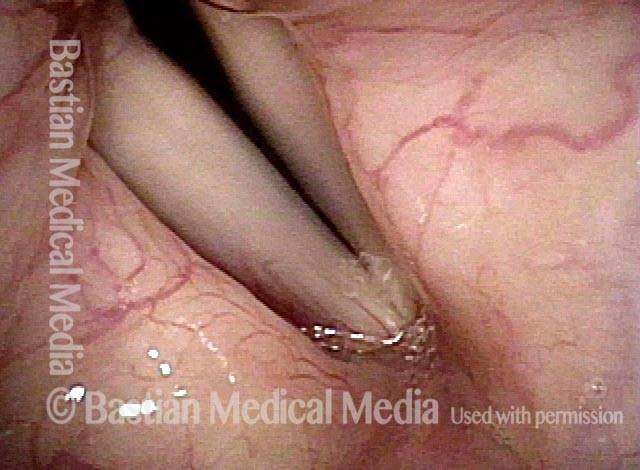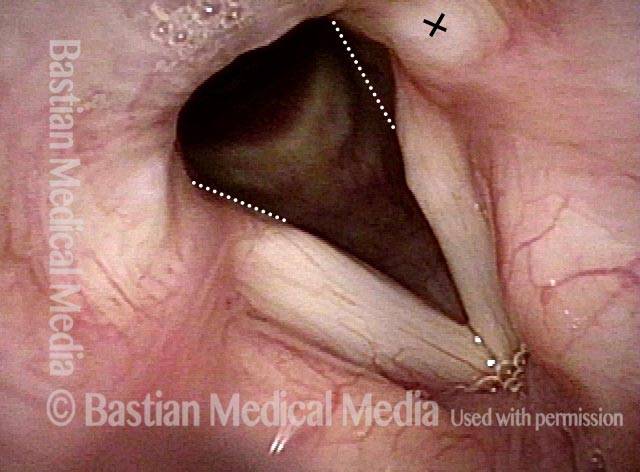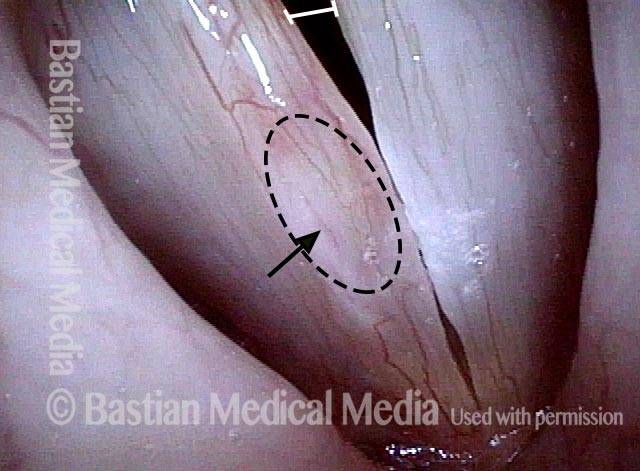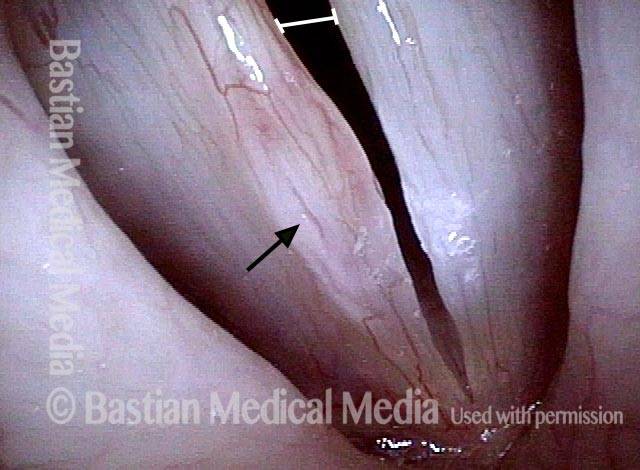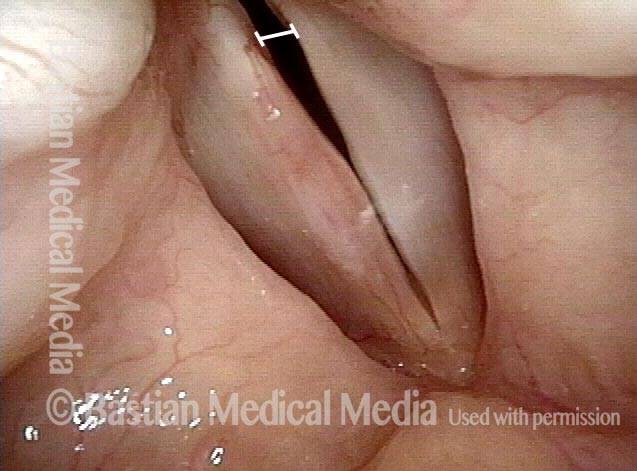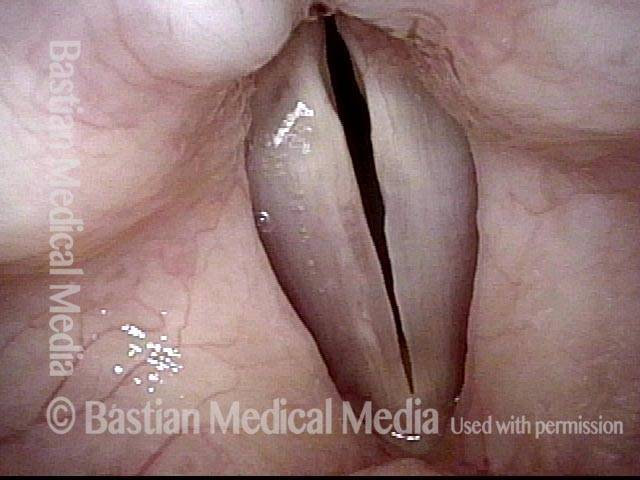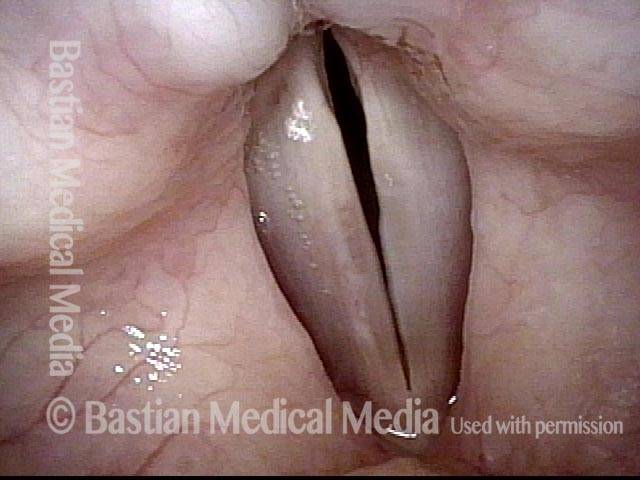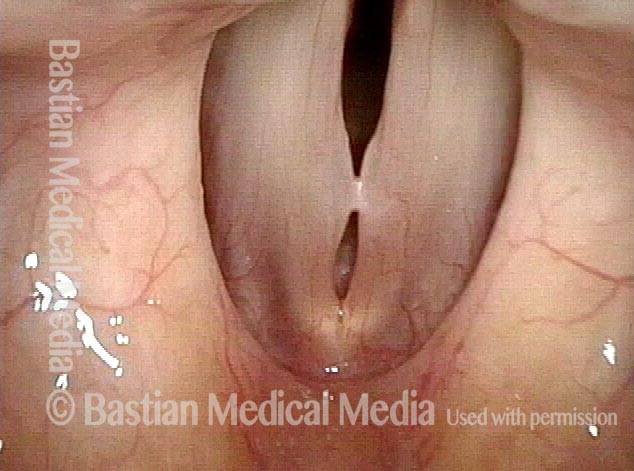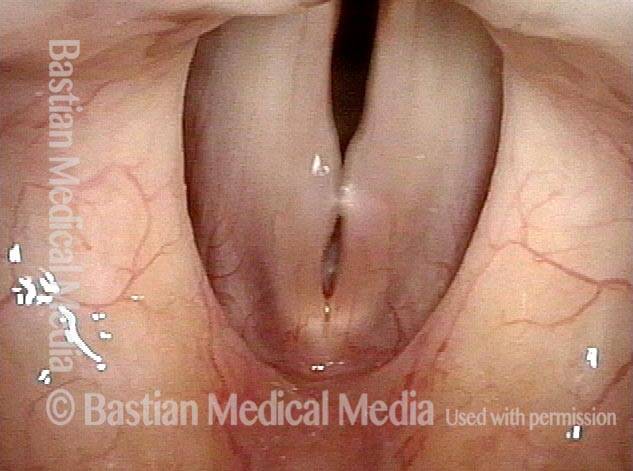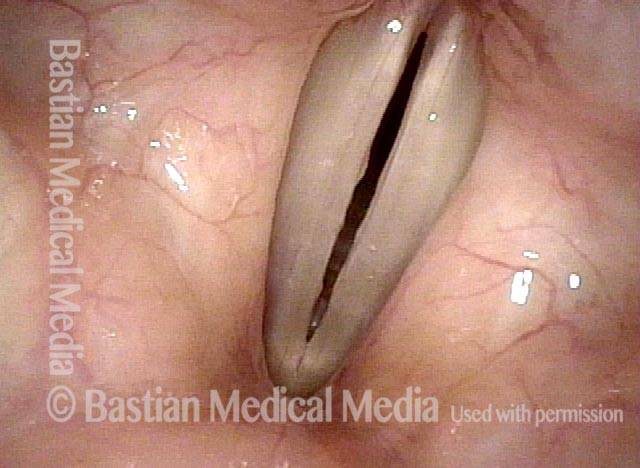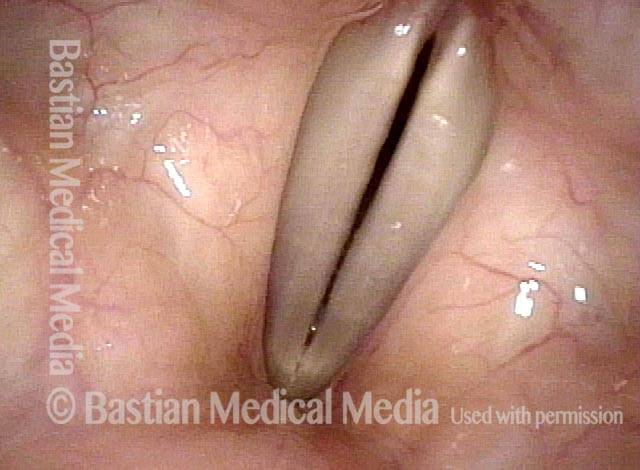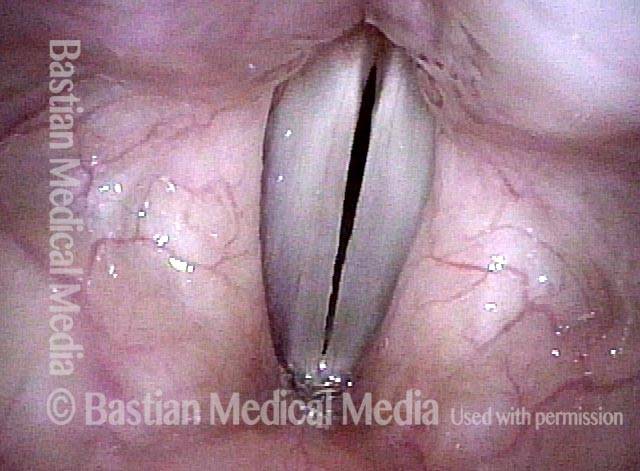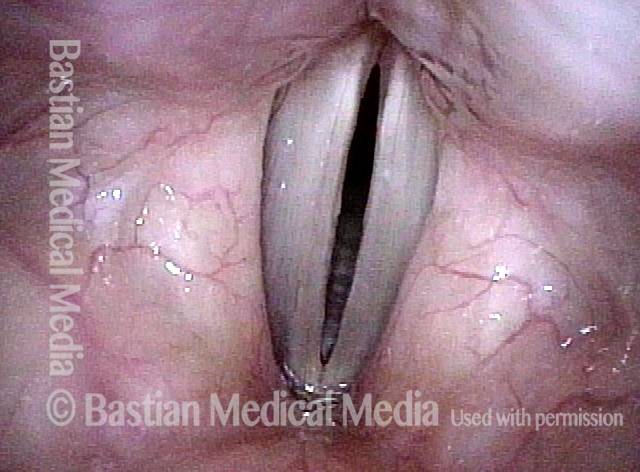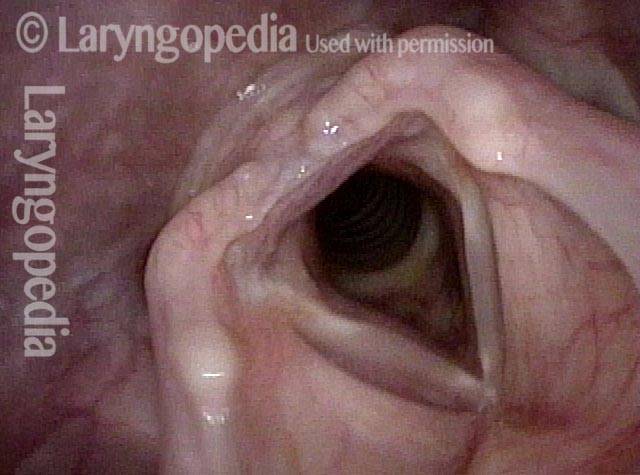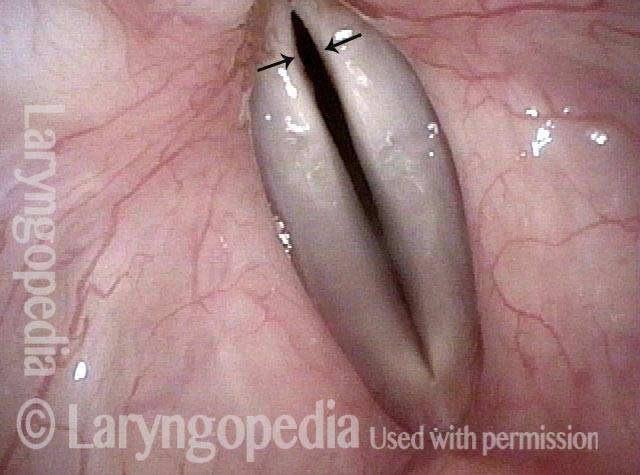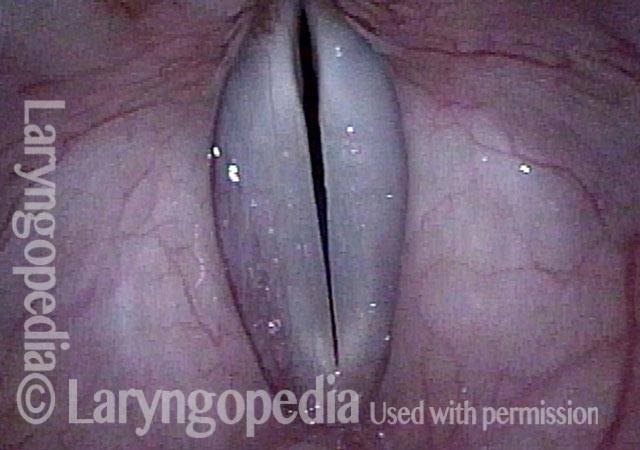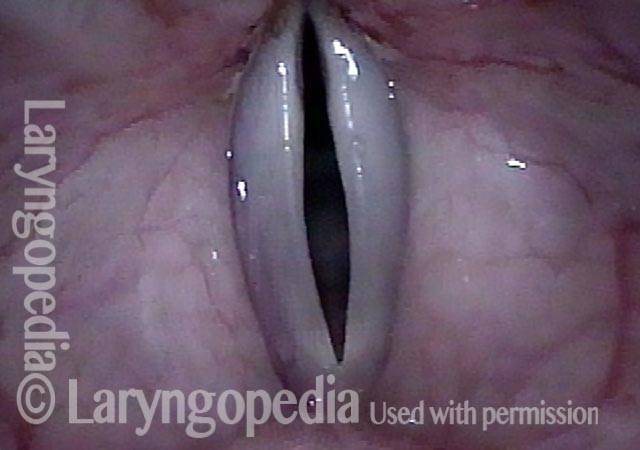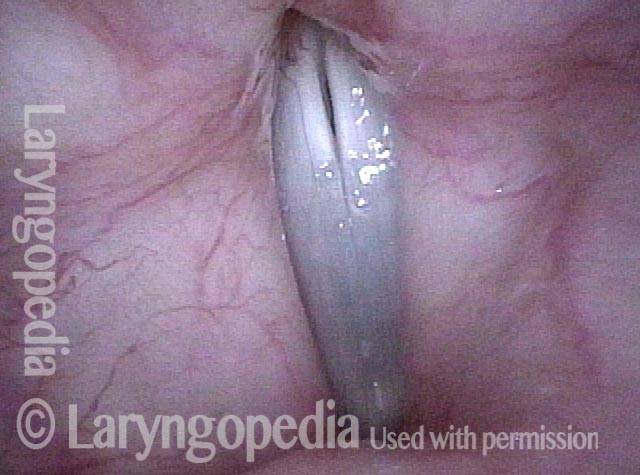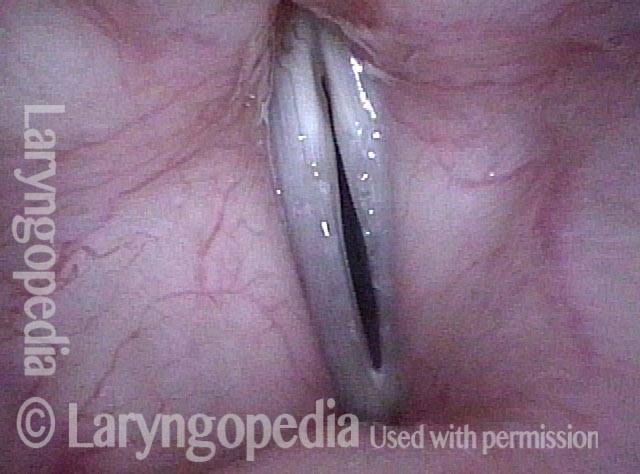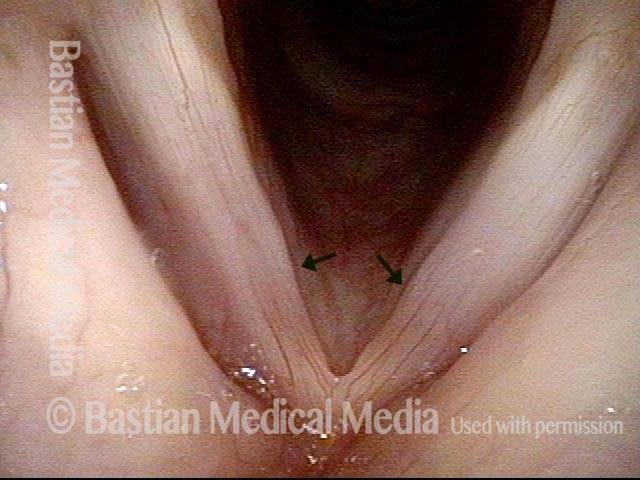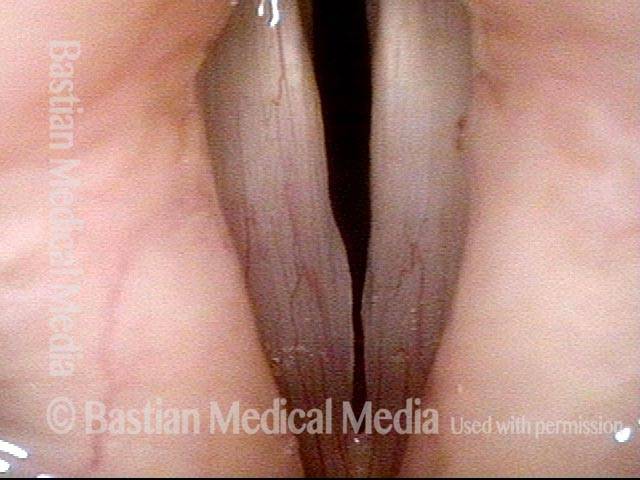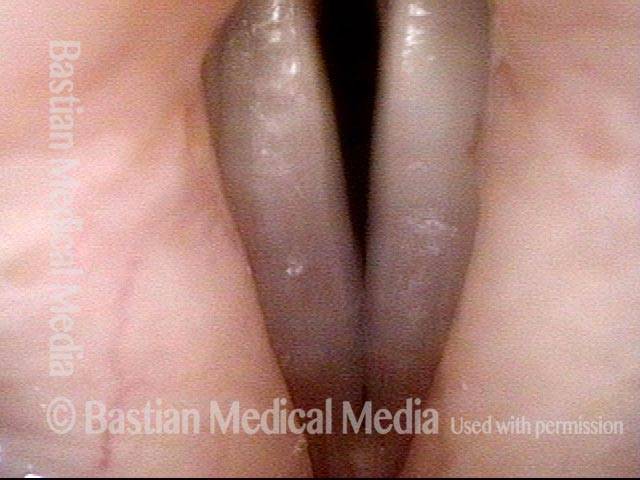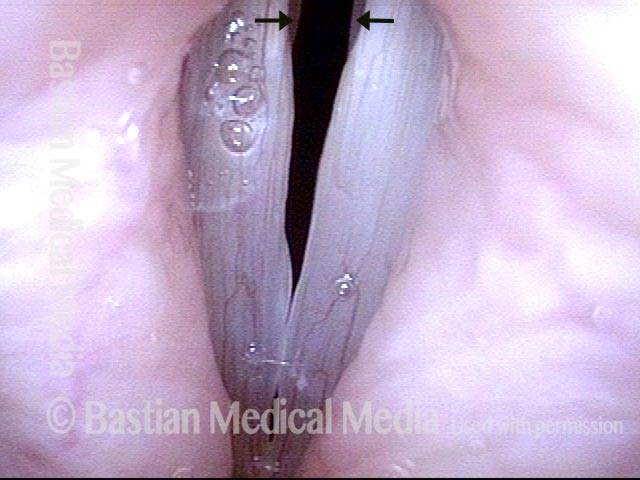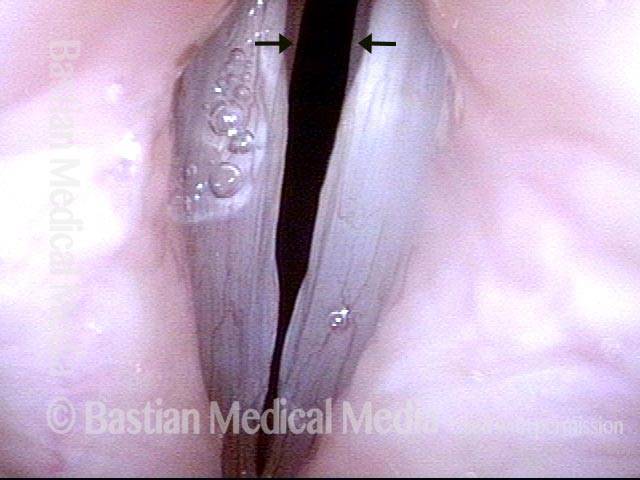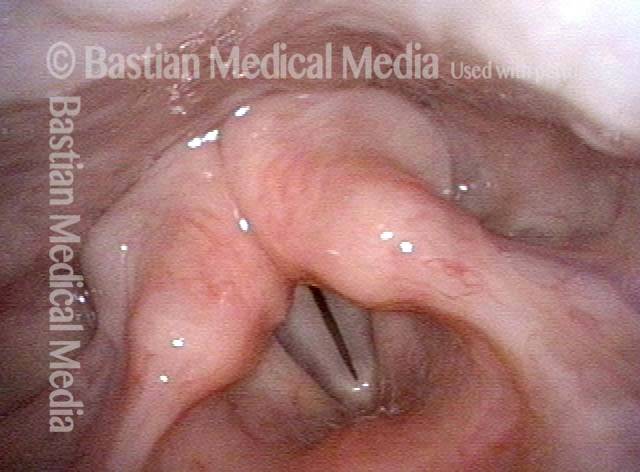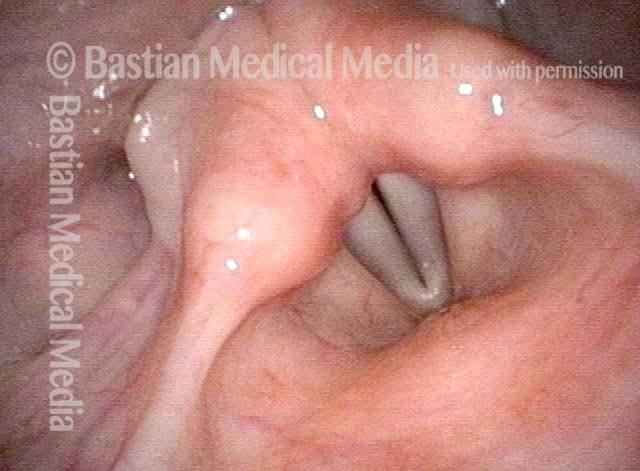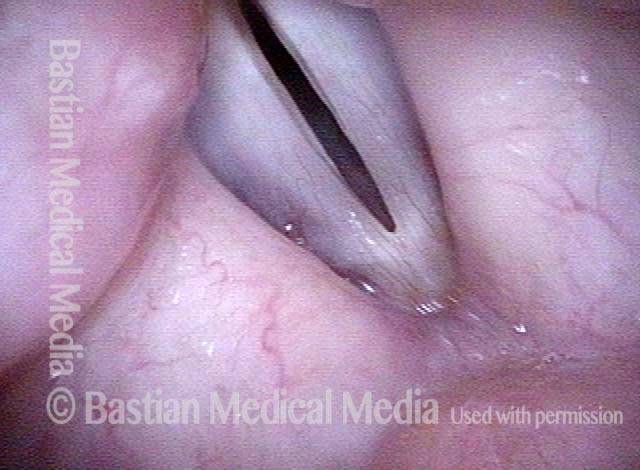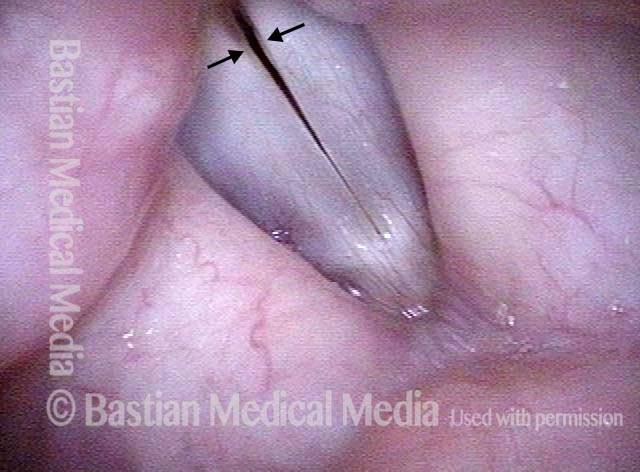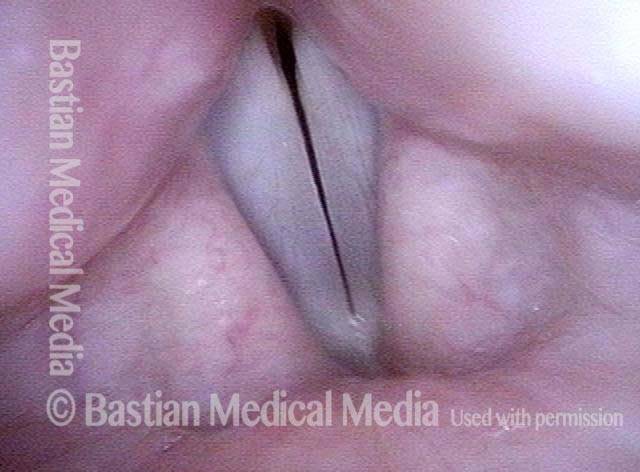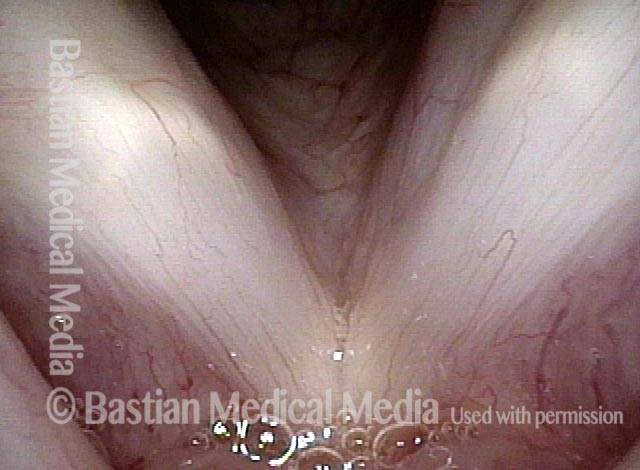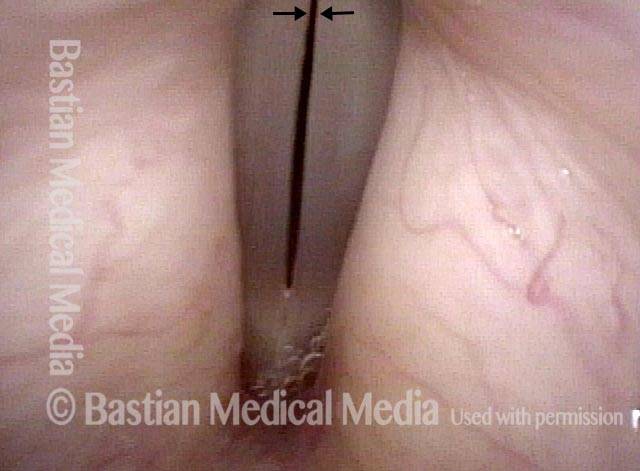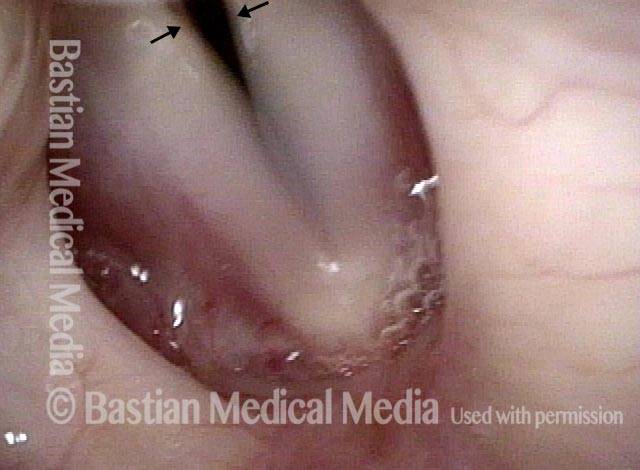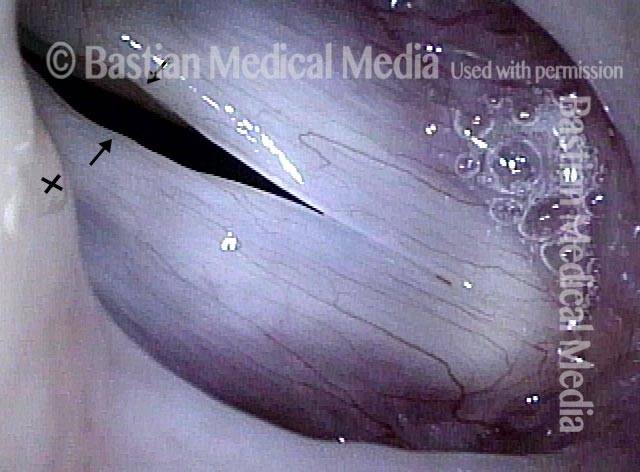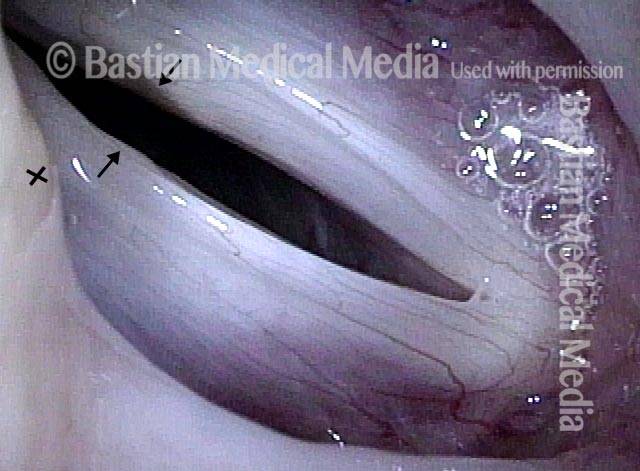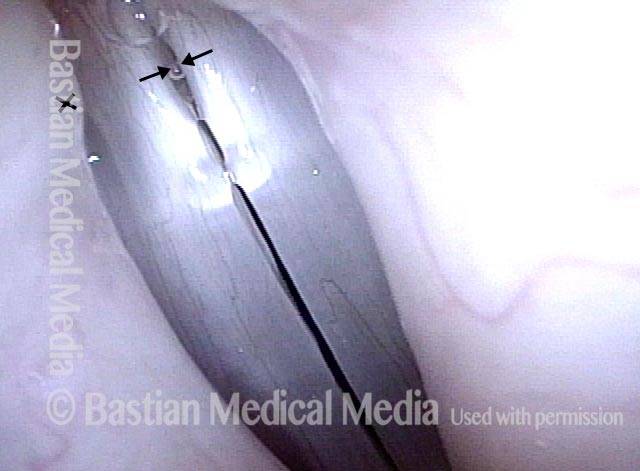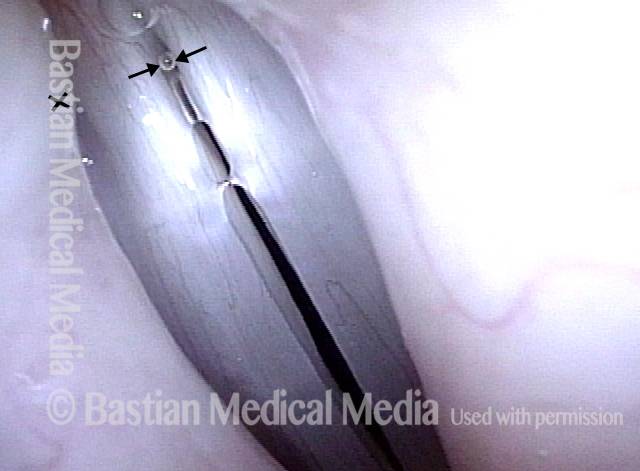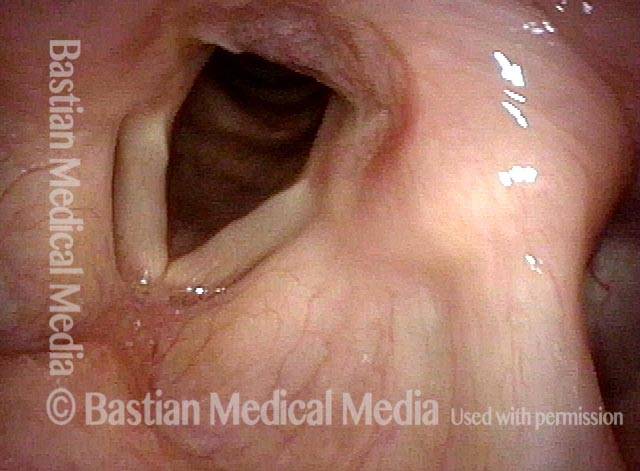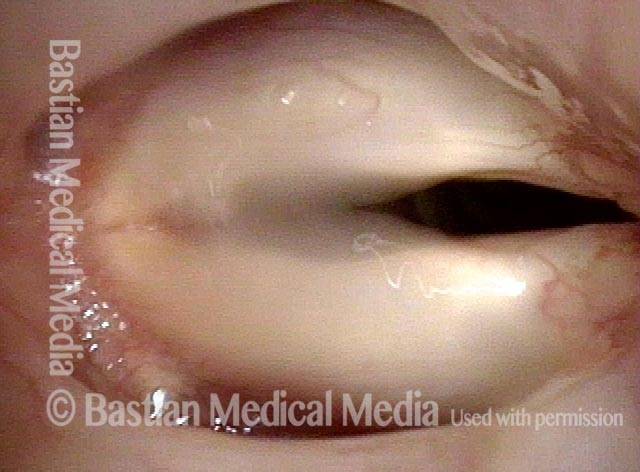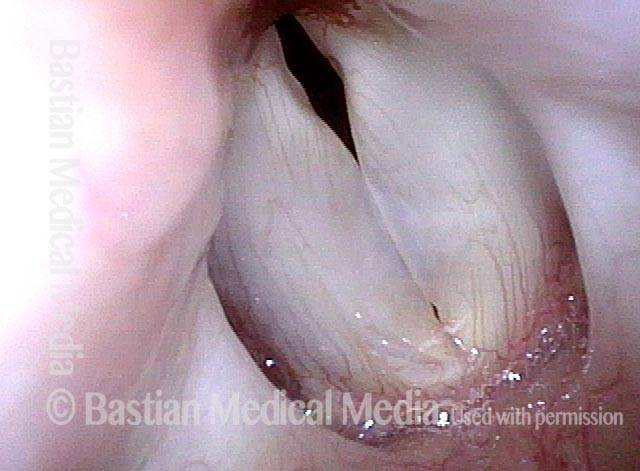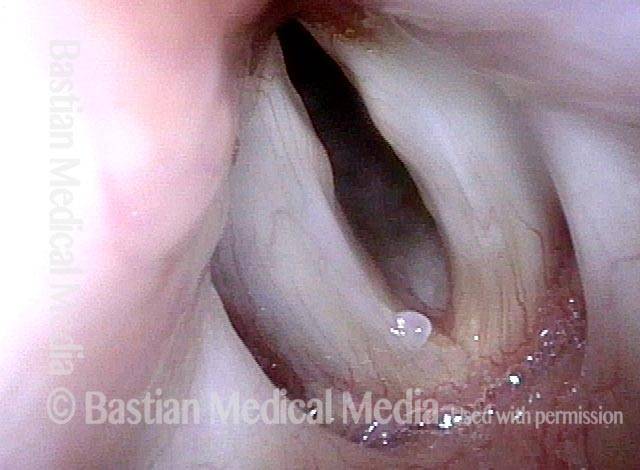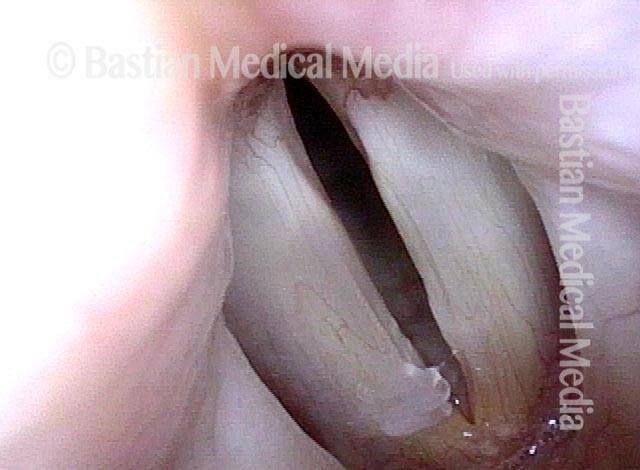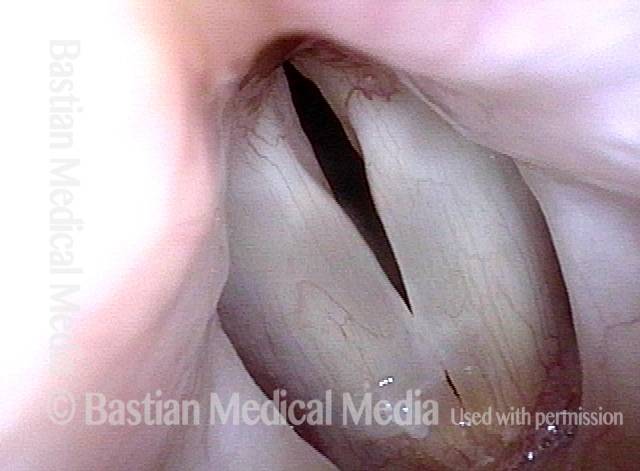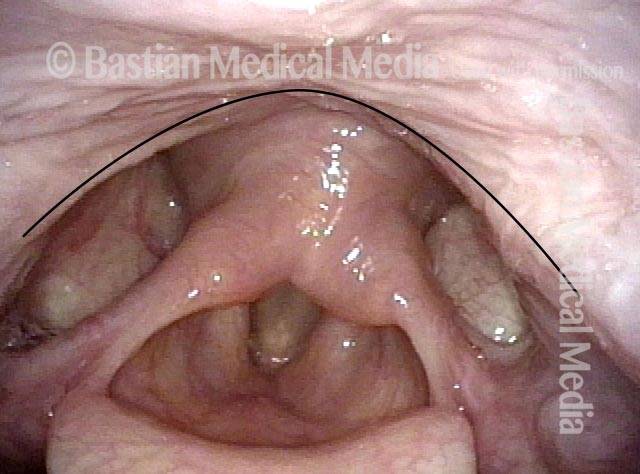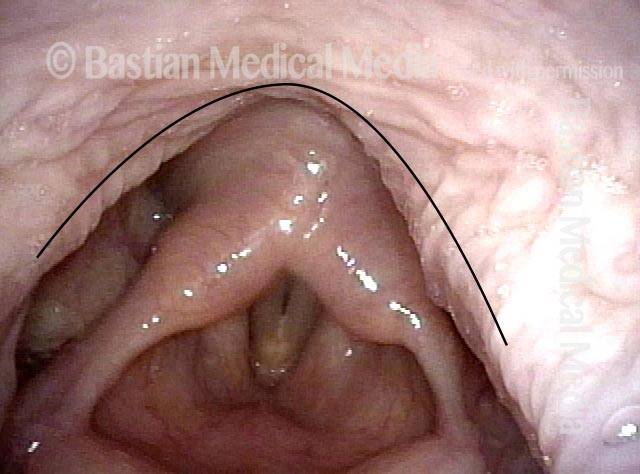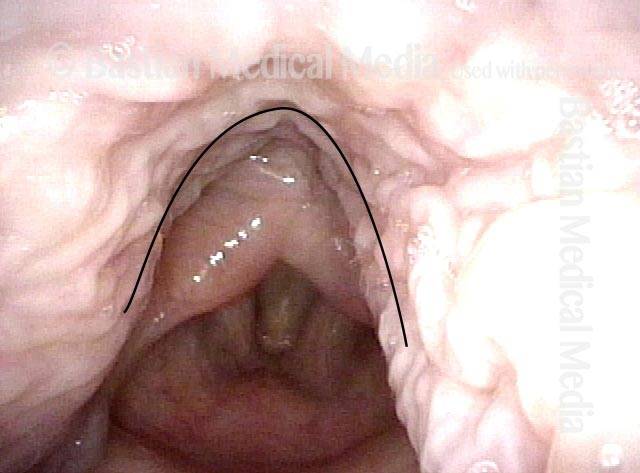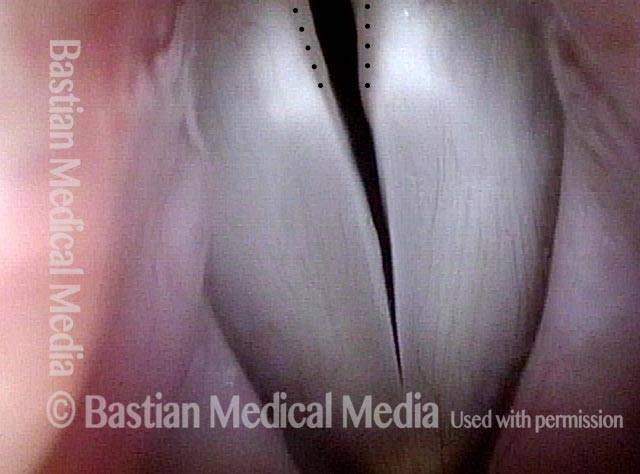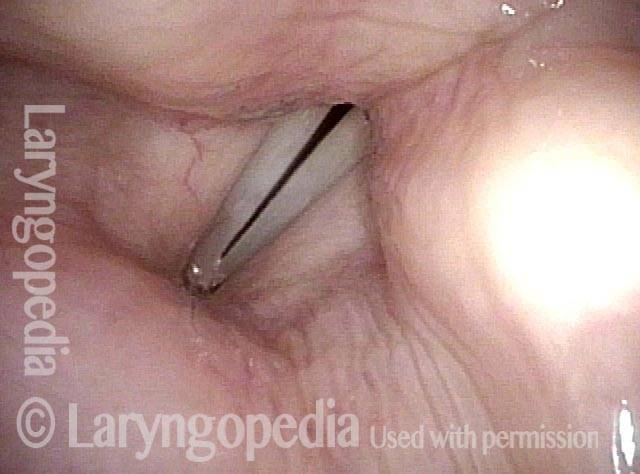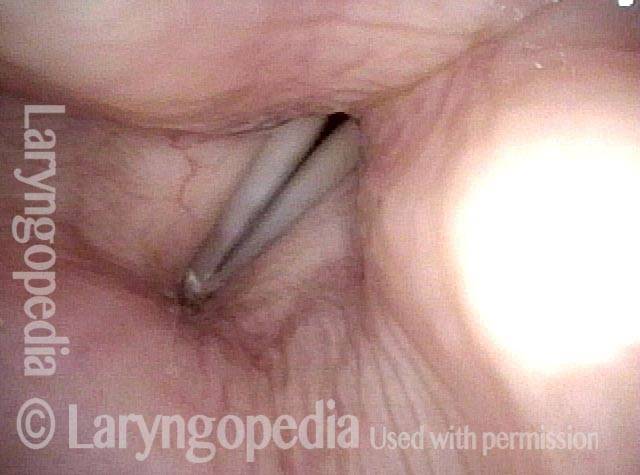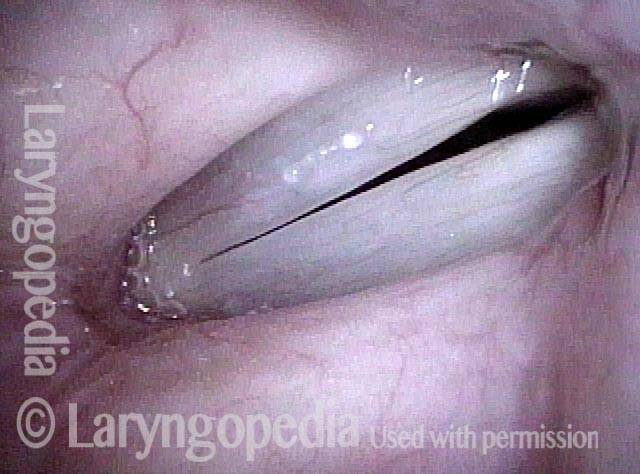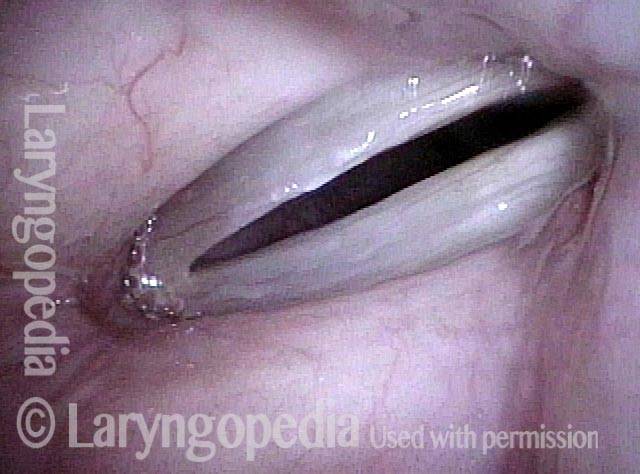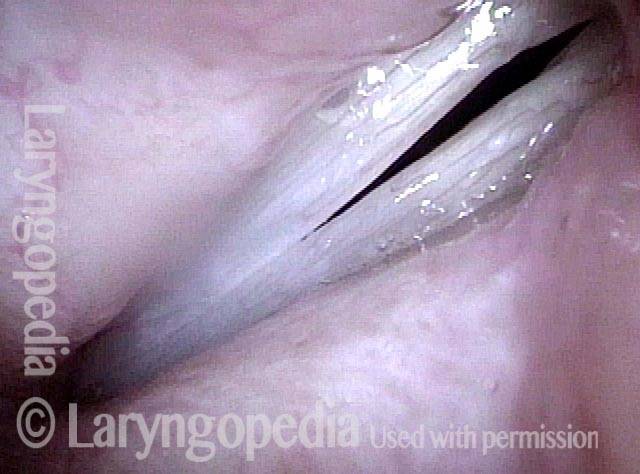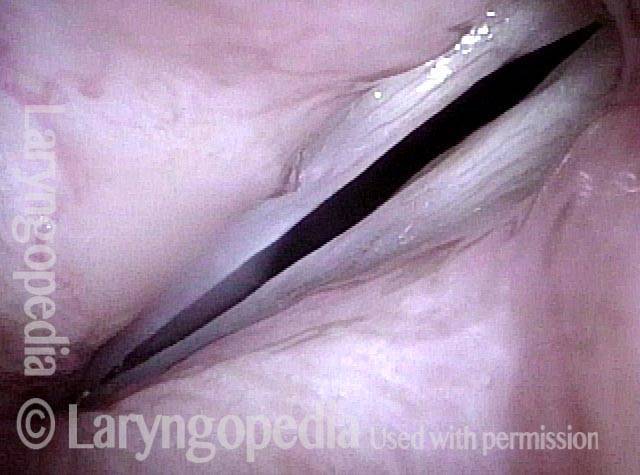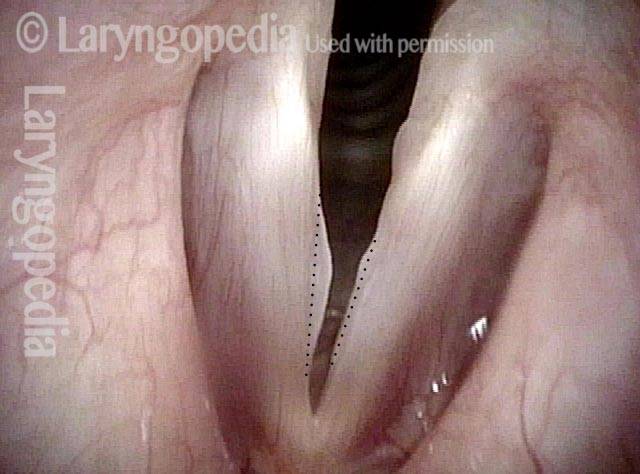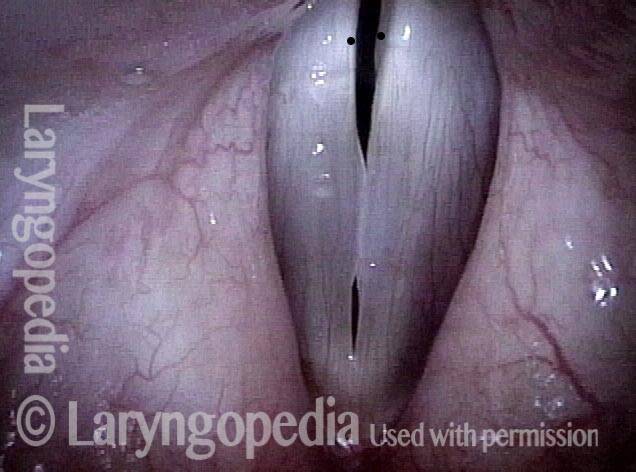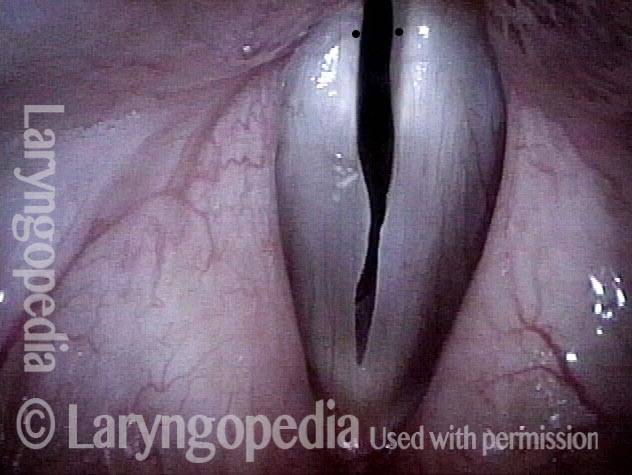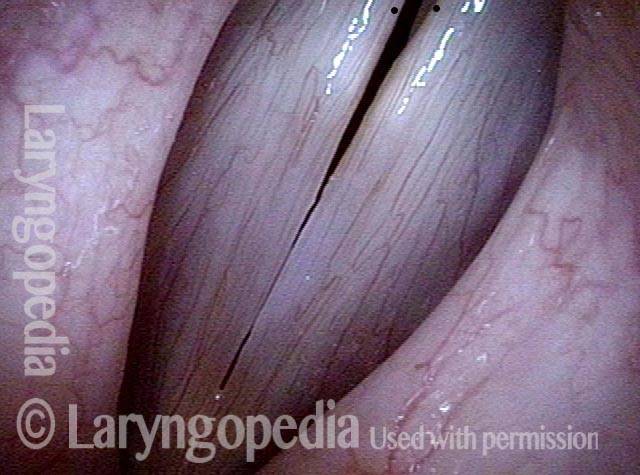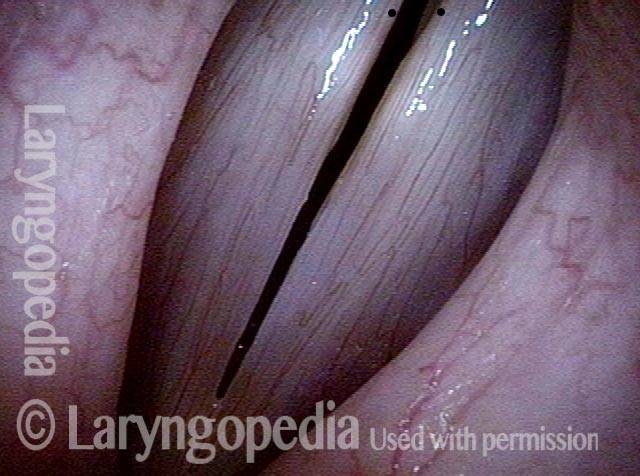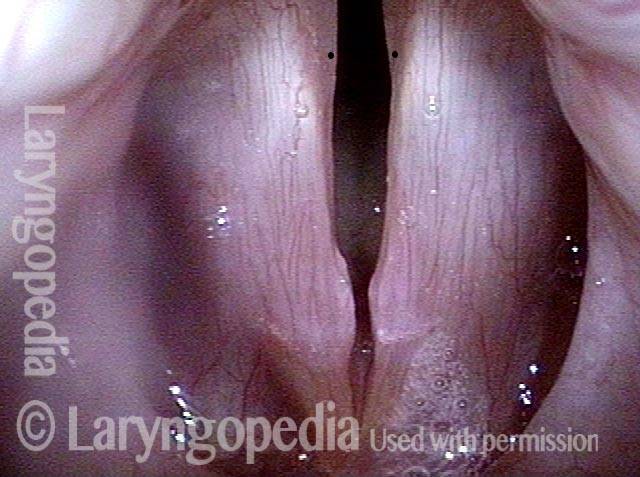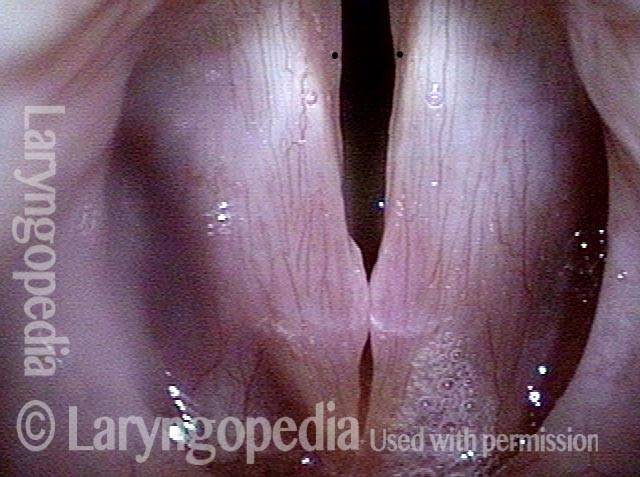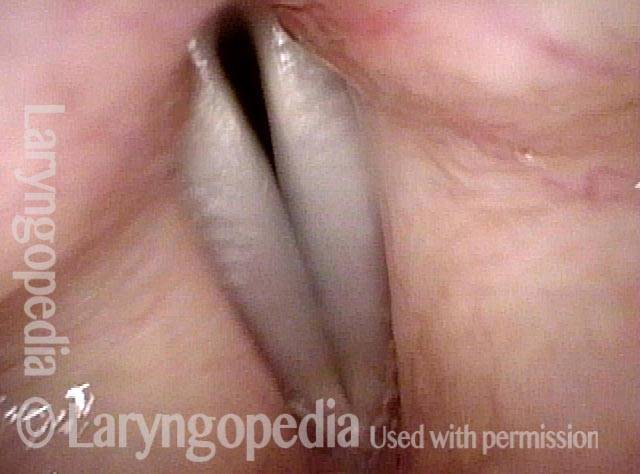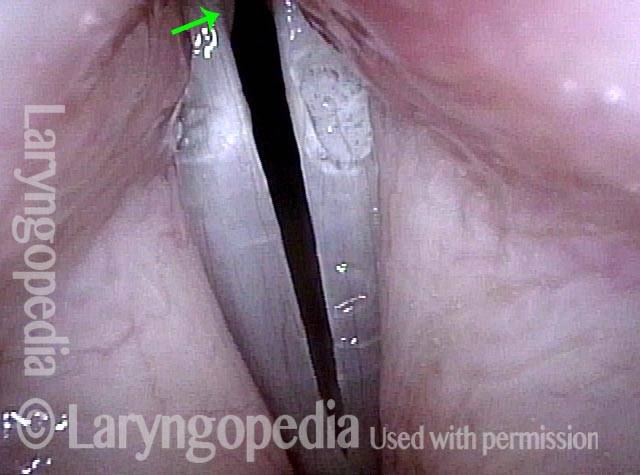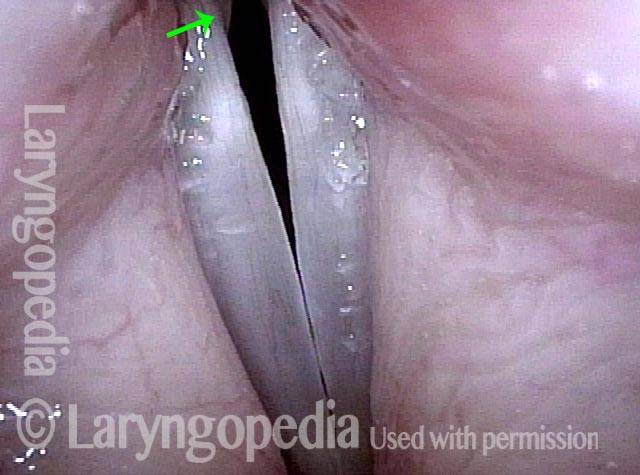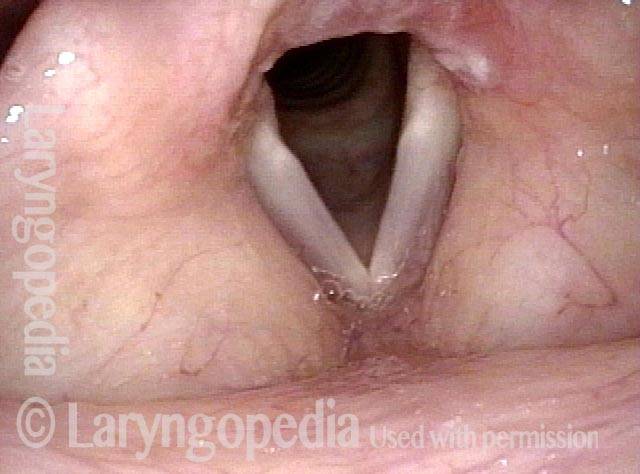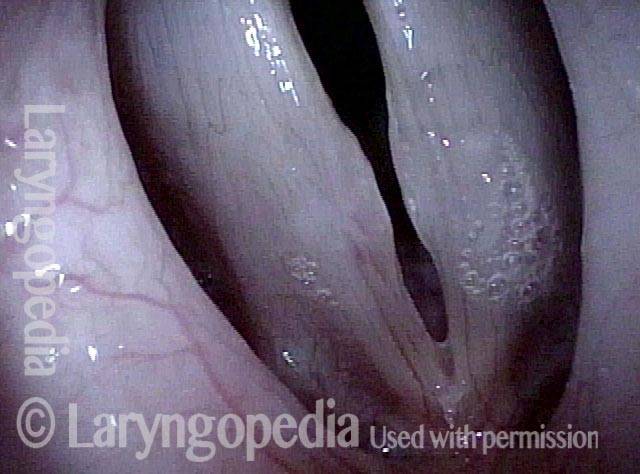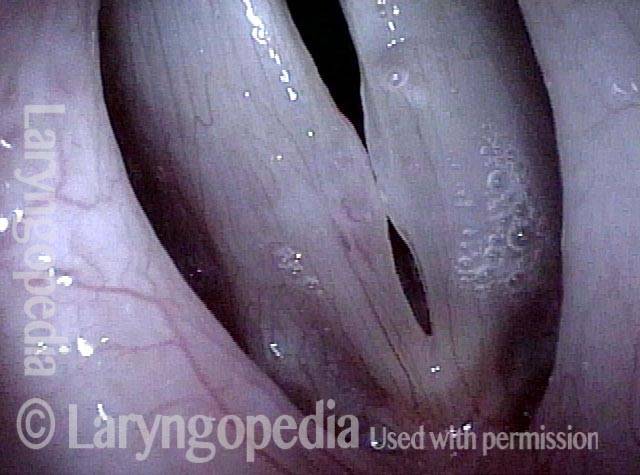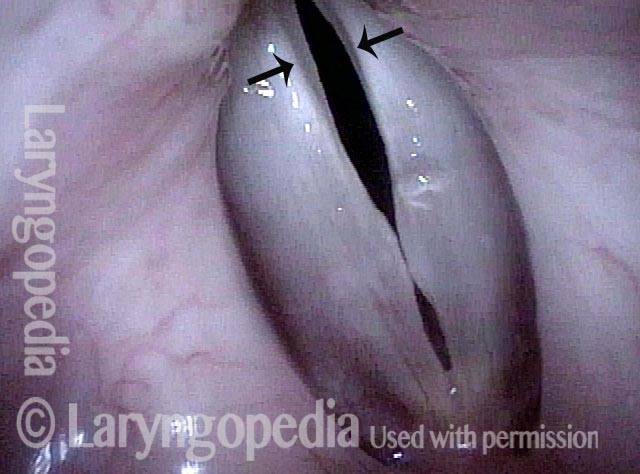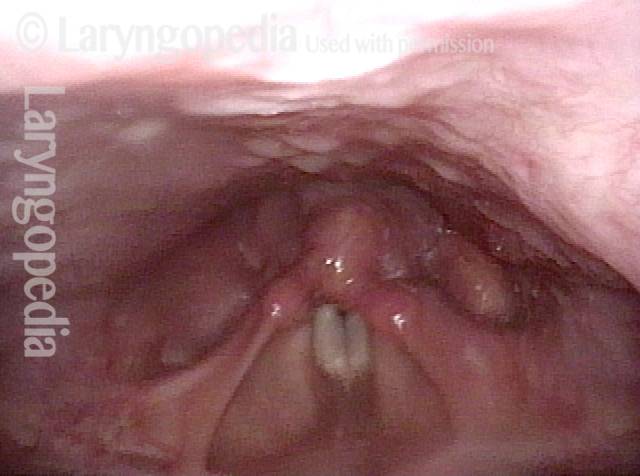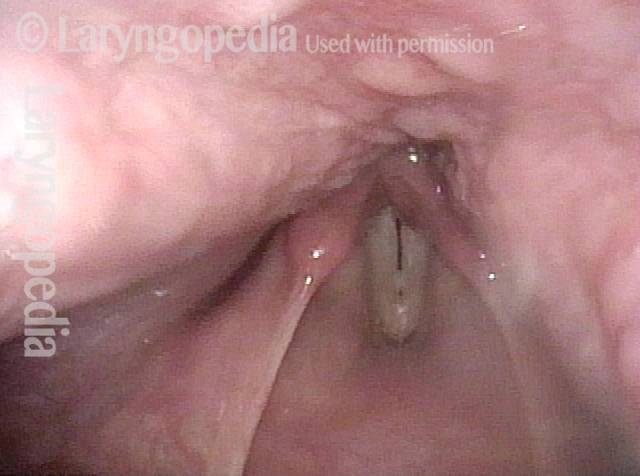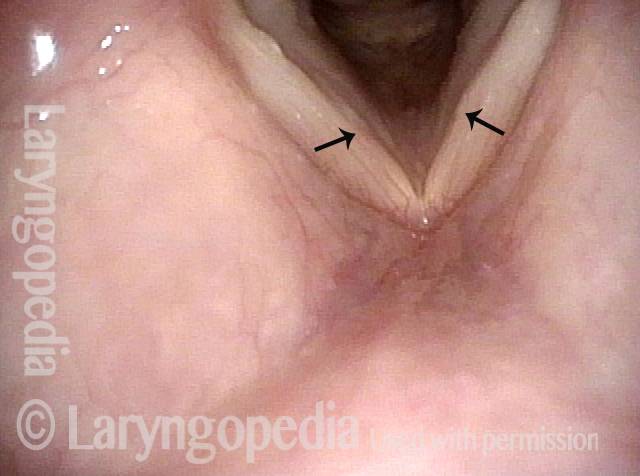Muscular Tension Dysphonia (MTD)
The term muscular tension dysphonia (MTD) was coined by Morrison and Rammage at the University of British Columbia. This is a syndrome consisting of some or all of the following:
- Excess tension, sometimes to the point of discomfort/ pain in the paralaryngeal and suprahyoid muscles;
- An open posterior glottic chink during phonation;
- High larynx position in the neck;
- Inappropriate contraction of pharyngeal constrictors with phonation;
- Often but not always, vibratory mucosal injury.
The vocal cord mucosal changes associated with MTD are usually fleshy vocal nodules. This syndrome is seen most often in young women.
Inappropriate Pharynx Contraction Is A Component of (MTD)
Rest Position of Pharynx (1 of 6)
Rest Position of Pharynx (1 of 6)
Inactive Pharynx Musculature (2 of 6)
Inactive Pharynx Musculature (2 of 6)
Contracted Pharynx (3 of 6)
Contracted Pharynx (3 of 6)
Contracted Pharynx (4 of 6)
Contracted Pharynx (4 of 6)
Greater Contraction of Pharynx (5 of 6)
Greater Contraction of Pharynx (5 of 6)
Phonating Larynx (6 of 6)
Phonating Larynx (6 of 6)
Use Different Views for MTD Than for Frequently-Associated Nodules
Convex vs. straight (1 of 4)
Convex vs. straight (1 of 4)
Swellings + MTD (2 of 4)
Swellings + MTD (2 of 4)
Strobe lighting (3 of 4)
Strobe lighting (3 of 4)
Use different views (4 of 4)
Use different views (4 of 4)
MTD Posturing Abnormality Transiently Corrected With Creaky Voice
Breathing position (1 of 6)
Breathing position (1 of 6)
MTD posturing (2 of 6)
MTD posturing (2 of 6)
“Closed” phase (3 of 6)
“Closed” phase (3 of 6)
Open phase (4 of 6)
Open phase (4 of 6)
Creaky voice, closed phase (5 of 6)
Creaky voice, closed phase (5 of 6)
Creaky voice, open phase (6 of 6)
Creaky voice, open phase (6 of 6)
Muscular Tension Dysphonia
Muscular tension dysphonia (1 of 4)
Muscular tension dysphonia (1 of 4)
Muscular tension dysphonia (2 of 4)
Muscular tension dysphonia (2 of 4)
Muscular tension dysphonia (3 of 4)
Muscular tension dysphonia (3 of 4)
Muscular tension dysphonia (4 of 4)
Muscular tension dysphonia (4 of 4)
Example 2
Muscular tension dysphonia (1 of 3)
Muscular tension dysphonia (1 of 3)
Muscular tension dysphonia (2 of 3)
Muscular tension dysphonia (2 of 3)
Muscular tension dysphonia (3 of 3)
Muscular tension dysphonia (3 of 3)
To See MTD, You Must See Posterior Commissure and Vocal Process Mucosa Especially at High Pitch
Breathy voice (1 of 4)
Breathy voice (1 of 4)
Posterior gap (2 of 4)
Posterior gap (2 of 4)
MTD (3 of 4)
MTD (3 of 4)
Open phase (4 of 4)
Open phase (4 of 4)
Severe MTD With “Red Herring” Mucus Retention Cyst and “Reflux” Findings
Possible reflux, barely visible lesion (1 of 4)
Possible reflux, barely visible lesion (1 of 4)
Closed phase at D4, posterior gap (2 of 4)
Closed phase at D4, posterior gap (2 of 4)
Closed phase at F#5, posterior gap (3 of 4)
Closed phase at F#5, posterior gap (3 of 4)
Red herring mucus retention cyst (4 of 4)
Red herring mucus retention cyst (4 of 4)
MTD at Prephonatory Instant, and During Phonatory Blurring
Prephonatory instant (1 of 2)
Prephonatory instant (1 of 2)
Phonatory blur (2 of 2)
Phonatory blur (2 of 2)
Looks Like MTD, but Isn’t
Weak, effortful voice (1 of 4)
Weak, effortful voice (1 of 4)
Prephonatory instant (2 of 4)
Prephonatory instant (2 of 4)
Phonatory blur (3 of 4)
Phonatory blur (3 of 4)
Endotracheal tube injury (4 of 4)
Endotracheal tube injury (4 of 4)
Persistent MTD and Pharynx Recruitment in Young Singer After Sulcus Removal
Squamous mucosa lining the sulcus (1 of 5)
Squamous mucosa lining the sulcus (1 of 5)
Open phase, distance posteriorly of cords (2 of 5)
Open phase, distance posteriorly of cords (2 of 5)
Closed phase, distance posteriorly of cords (3 of 5)
Closed phase, distance posteriorly of cords (3 of 5)
Two weeks post-surgery, MTD (4 of 5)
Two weeks post-surgery, MTD (4 of 5)
Re-posture vocal mechanism (5 of 5)
Re-posture vocal mechanism (5 of 5)
MTD and Postoperative “Gap Memory”
Prephonatory instant (1 of 6)
Prephonatory instant (1 of 6)
Phonatory blur (2 of 6)
Phonatory blur (2 of 6)
Post-op, persistant gap (3 of 6)
Post-op, persistant gap (3 of 6)
Large gap (4 of 6)
Large gap (4 of 6)
Strobe light (5 of 6)
Strobe light (5 of 6)
Strobe light, open phase (6 of 6)
Strobe light, open phase (6 of 6)
MTD Briefly Abolished with Creaky Voice
Breathing position (1 of 6)
Breathing position (1 of 6)
MTD posturing (2 of 6)
MTD posturing (2 of 6)
Gap (3 of 6)
Gap (3 of 6)
Open phase (4 of 6)
Open phase (4 of 6)
Creaky voice (5 of 6)
Creaky voice (5 of 6)
Open phase (6 of 6)
Open phase (6 of 6)
Mind the GAP!
Bilateral vocal cord swellings (1 of 5)
Bilateral vocal cord swellings (1 of 5)
MTD gap (2 of 5)
MTD gap (2 of 5)
Phonatory blur (3 of 5)
Phonatory blur (3 of 5)
Vocal processes (4 of 5)
Vocal processes (4 of 5)
Surgery? (5 of 5)
Surgery? (5 of 5)
Indicator Lesions and MTD
Breathy voice (1 of 6)
Breathy voice (1 of 6)
Phonation (2 of 6)
Phonation (2 of 6)
Open phase (3 of 6)
Open phase (3 of 6)
Closed phase (4 of 6)
Closed phase (4 of 6)
Open phase, indicator lesions (5 of 6)
Open phase, indicator lesions (5 of 6)
“Closed” phase, MTD (6 of 6)
“Closed” phase, MTD (6 of 6)
Quasi-Muscular Tension Dysphonia: the Real Thing Is Usually Throughout the Range
Seemingly normal vocal cords (1 of 7)
Seemingly normal vocal cords (1 of 7)
Good approximation (2 of 7)
Good approximation (2 of 7)
Muscular tension dysphonia (3 of 7)
Muscular tension dysphonia (3 of 7)
Breathiness (4 of 7)
Breathiness (4 of 7)
Open phase (5 of 7)
Open phase (5 of 7)
Closed phase (6 of 7)
Closed phase (6 of 7)
Approximated vocal processes (7 of 7)
Approximated vocal processes (7 of 7)
Severe MTD or Bilateral LCA Weakness?
Breathiness (1 of 6)
Breathiness (1 of 6)
Phonation (2 of 6)
Phonation (2 of 6)
Closed phase (3 of 6)
Closed phase (3 of 6)
Large gap (5 of 6)
Large gap (5 of 6)
Open phase (6 of 6)
Open phase (6 of 6)
MTD: Vocal Cord Posture and Pharynx Recruitment Often Come Together
Phonation, A3 (1 of 4)
Phonation, A3 (1 of 4)
Pharynx contracted (2 of 4)
Pharynx contracted (2 of 4)
Maximum contraction (3 of 4)
Maximum contraction (3 of 4)
“Closed” phase (4 of 4)
“Closed” phase (4 of 4)
MTD at A Distance and Up Close
Posterior gap (1 fo 6)
Posterior gap (1 fo 6)
Phonation (2 of 6)
Phonation (2 of 6)
Strobe light, closed phase (3 of 6)
Strobe light, closed phase (3 of 6)
Strobe light, open phase (4 of 6)
Strobe light, open phase (4 of 6)
Closed phase (5 of 6)
Closed phase (5 of 6)
Open phase (6 of 6)
Open phase (6 of 6)
Self-correcting MTD
Swellings (1 of 5)
Swellings (1 of 5)
Closed phase (2 of 5)
Closed phase (2 of 5)
Open phase (3 of 5)
Open phase (3 of 5)
Post microsurgery (4 of 5)
Post microsurgery (4 of 5)
MTD post surgery (5 of 5)
MTD post surgery (5 of 5)
MTD Phonatory Gap Greater Than Required By Swelling
Open phase (1 of 2)
Open phase (1 of 2)
Closed phase (2 of 2)
Closed phase (2 of 2)
Released to Sing, and A Surprise Explanation for Pain
Voice major complains of pain (1 of 4)
Voice major complains of pain (1 of 4)
Open phase (2 of 4)
Open phase (2 of 4)
Closed phase (3 of 4)
Closed phase (3 of 4)
Cause of pain (4 of 4)
Cause of pain (4 of 4)
Search not Only for Nodules, but Also for Segmental Vibration and Look at the Posterior Commissure for MTD
Open phase (1 of 4)
Open phase (1 of 4)
Closed phase (2 of 4)
Closed phase (2 of 4)
Segmental vibration (3 of 4)
Segmental vibration (3 of 4)
Posterior commissure (4 of 4)
Posterior commissure (4 of 4)
Muscular, not Mucosal Ceiling Diagnosable Even with Distant Views
Low voice at a distance, pharynx is relaxed (1 of 3)
Low voice at a distance, pharynx is relaxed (1 of 3)
Maximal contraction of pharynx (2 of 3)
Maximal contraction of pharynx (2 of 3)
Vocal cord swellings are red herrings (3 of 3)
Vocal cord swellings are red herrings (3 of 3)

Loss of Upper Voice Caused by Lowered Muscular Ceiling (MTD)
Every voice has a natural range (from its “floor” to its “ceiling”), often 2 ½ octaves or more. Over time, some singers notice upper range loss or effortfulness (the ceiling descends). Yet there are no nodules or polyps.
When the “muscular ceiling” descends, it feels and sounds like the voice has to be pushed up to its upper range and the throat may almost ache with the effort. And pitch may sag.
A common association in women is menopause, but it can be seen in either sex at any age.
